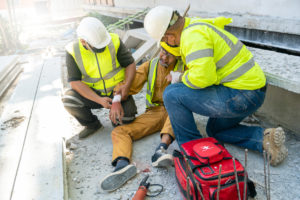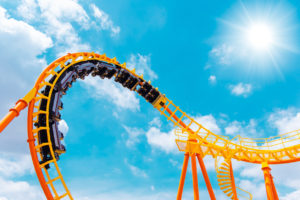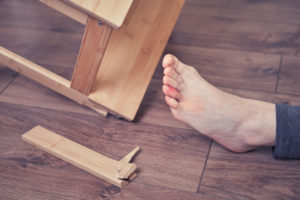Key Points:
- Despite stringent regulations from OSHA, workers in the construction industry still endure severe, life-altering accidents daily.
- Besides your employer, other third parties might be responsible for your accident and could be liable for damages.
- If you’ve suffered an injury at work, it’s advisable to consult with a personal injury lawyer before accepting any compensation from your employer or their insurance provider.
In the construction industry, your daily responsibilities might include operating heavy machinery, ascending to impressive heights, or navigating the complexities of electrical lines—activities fraught with risk. These essential but hazardous duties can, unfortunately, lead to accidents and injuries.
To protect workers, the federal government established the Occupational Safety and Health Administration (OSHA). This agency sets and enforces safety standards in the workplace, requiring businesses to adhere to strict regulations. Despite these precautions, accidents can still occur.
If you suffer an injury at a construction site or other workplace, you may be entitled to compensation from your employer or other responsible parties. Understanding your rights and the benefits of legal assistance is crucial in these situations. A lawyer can provide the guidance needed to navigate the claims process effectively.
What are the Hazards that are at Construction Sites?
Construction sites are fraught with hazards, yet four major dangers stand out, often referred to by OSHA as the “Big 4”:
- Falls from Heights: Whether it’s from ladders, scaffolding, or boom trucks, falls can occur from significant heights, sometimes resulting in life-threatening or even fatal injuries.
- Electrocution: Those working with generators, power tools, and electrical wiring face risks of electrical shocks and flash burns. Linemen, for example, repairing lines in the dark or during storms, are especially vulnerable to electrocution.
- Crush and Impact Injuries: The use of bulldozers, backhoes, cranes, and other heavy machinery increases the likelihood of crush and impact incidents, where workers might be struck by or run over.
- Struck by Moving Objects: Injuries may also arise from forcible contact with equipment that is falling, swinging, or rolling.
Additional common injuries at construction sites include burns, eye injuries potentially leading to temporary or permanent blindness, bone fractures, limb loss, injuries to knees, ankles, or feet, as well as spinal injuries which may involve the neck, shoulders, or back, potentially leading to paralysis. Exposure to toxic chemicals and various head injuries, including concussions and traumatic brain injuries (TBI), are also prevalent.
The spectrum of potential injuries ranges from minor cuts and bruises to severe, life-altering conditions and, tragically, sometimes death. If you have experienced an injury at work, it is crucial to seek medical attention and consider consulting with a personal injury lawyer to understand your rights and potential compensation.
Are Construction Companies Frequently Negligent, Resulting in Injuries to their Workers?
When company owners and supervisors fail to uphold safety measures on the job site, workers are frequently injured as a result. Securing compensation for workplace injuries can be challenging in Atlanta, making it essential to thoroughly explore all available options to fulfill your claim. Consulting with an attorney who specializes in work-related injuries can be particularly beneficial. Experienced in navigating the complexities of work-related accident claims, a skilled attorney can manage the legal aspects of your case, allowing you to focus on recovery. This approach often proves to be the most effective way to safeguard your rights and ensure you receive the compensation you deserve.
What Types of Construction Sites Are Common Around Atlanta?
Construction is booming in Atlanta, reflecting the city’s robust economic growth and increasing population. As the skyline continues to transform and neighborhoods expand, the demand for new infrastructure and living spaces is evident. Various types of construction sites have become a common sight across the region, catering to a diverse array of development needs. Here’s a look at some of the most prevalent types of construction projects you’ll find around Atlanta:
- Residential Construction: Developments include everything from single-family homes to expansive apartment complexes and high-rise condominiums, meeting the housing demands of Atlanta’s growing population.
- Commercial Construction: The city’s commercial landscape is constantly evolving with new office buildings, retail centers, and luxury hotels, particularly prominent in thriving areas like Midtown and Buckhead.
- Industrial Construction: On the city’s outskirts and near major transport hubs, construction of warehouses and manufacturing facilities supports Atlanta’s role as a logistics and distribution powerhouse.
- Road and Infrastructure Projects: With its vast network of roads and highways, Atlanta regularly undertakes road construction, bridge repairs, and expansions to enhance connectivity and traffic flow.
- Public Works and Utilities: These projects are crucial for urban living, encompassing upgrades to water treatment facilities, sewer systems, and expansions of public transportation networks like MARTA.
Each of these construction sectors offers a risk of personal injury.
What Are Common Forms of Negligence By Employers at Construction Site Accidents?
Accidents on construction sites can often be traced back to various forms of negligence:
Construction sites typically require the use of personal protective equipment like hardhats, safety glasses, protective footwear, and safety harnesses. However, not all companies consistently enforce these safety measures or maintain a safe working environment, leading to serious and sometimes irreversible injuries.
Equipment that is outdated or poorly maintained poses additional risks. Safety features may fail, leading to accidents caused by unguarded power saws, unstable ladders or scaffolding, frayed electrical wires, or compromised safety harnesses and glasses.
Neglect in maintaining the worksite itself can create hazards such as tripping risks and falling objects. It is crucial that areas prone to spills or other dangers are promptly marked with warning signs to alert workers.
Furthermore, construction companies are responsible for providing thorough and ongoing training on safety practices. A failure to do so constitutes negligence.
Regrettably, the high costs of upholding safety standards often lead companies to cut corners, prioritizing profits over worker safety. This issue is exacerbated when workers are hurried to meet tight deadlines, increasing the risk of accidents due to these safety oversights.
Can a Third Party Contractor or Business Be Responsible for a Construction Site Accident?
While your employer might be liable for injuries sustained on the job, responsibility may also extend to third parties like subcontractors or equipment manufacturers. For instance, if a failure by an electrical or roofing contractor to maintain a safe environment contributed to the accident, or if safety equipment was defective, these third parties can be held accountable. The involvement of negligent subcontractors or manufacturers could be crucial, highlighting the importance of a thorough examination of all aspects of the accident scene.
Be aware that the construction company, their insurers, and any associated third parties will often vigorously defend themselves against claims of negligence. They might even attempt to influence witnesses and coworkers to withhold support or evidence that could assist your case, such as denying access to video footage of the incident. Engaging a lawyer can safeguard your rights and ensure that all necessary evidence is preserved and made available, potentially through a court order.
What Types of Evidence Do Personal Injury Lawyers Prioritize at a Construction Site?
Personal injury lawyers meticulously gather a variety of evidence when handling construction site accidents, aiming to construct a compelling case for their clients. Here are some key forms of evidence they focus on:
- Photographic and Video Documentation: Capturing the scene at the time of the accident through photos and videos can reveal critical details about environmental conditions, equipment placement, and other factors that may have led to the incident.
- Witness Testimonies: Insights from coworkers, other contractors, and onlookers who witnessed the accident or the circumstances surrounding it are invaluable. Their firsthand accounts can underscore claims of negligence and unsafe practices.
- Accident Reports: These official documents, whether prepared by the company or emergency personnel, are rich with details about the incident and offer preliminary insights from the immediate investigation.
- Medical Records: Detailed records of the injuries sustained provide concrete evidence of the physical consequences of the accident and link them directly to the event.
- Safety Records: An examination of the company’s historical safety protocols and incident records can reveal patterns of oversight or habitual safety failings.
- Equipment Maintenance Logs: These logs are crucial for demonstrating whether equipment malfunctions due to poor maintenance contributed to the accident.
- Training Records: Records proving the training and qualifications of personnel can help ascertain if insufficient training played a role in the accident.
- Compliance Documentation: Proof of adherence to—or violations of—safety regulations, like those mandated by OSHA, can show whether the company met its legal safety obligations.
Can a Construction Worker Be Compensated from Workers Comp and a Work Injury Lawsuit?
Yes, a construction worker can be compensated from both workers’ compensation and a separate work injury lawsuit under certain conditions. Workers’ compensation is a straightforward system that provides benefits like medical expense coverage and partial wage replacement, regardless of who was at fault for an injury. This system usually prevents a worker from suing their employer directly. However, if a third party—like an equipment manufacturer or another subcontractor—is responsible for the injury, the worker may file a lawsuit against that party. For example, if a faulty tool causes an injury, the worker could claim workers’ compensation and also sue the tool’s manufacturer. This dual path allows injured workers to potentially receive more comprehensive compensation for their losses.

 1201 West Peachtree Street #2339 Atlanta, GA 30309+1-770-212-3795$0-$100000
1201 West Peachtree Street #2339 Atlanta, GA 30309+1-770-212-3795$0-$100000Never once have I doubt it or regretted reaching out to them. I wish so many other law firms were so concerned about their clients. I’m just saying in my opinion Millar law firm is the best.. don’t hesitate reach out to them call them… You really can’t go wrong.
















